
In a world where convenience takes center stage, one essential resource stands out for its ubiquity and importance- liquified petroleum gas (LPG). From cooking sumptuous meals to fulfilling commercial and industrial fuel requirements, LPG is an indispensable part of life. However, LPG cylinders and pipelines are flammable if leakage happens due to improper installation, so, it is important to be safe while handling any fuels and LPG is no longer an exception in this parameter.
Following simple safety tips during operation and installation can ensure the LPG cylinder does the job it is meant to do, without adding extra burden to our lives. As an LPG gas company, the compliance to safety falls onto themselves to ensure there is no leakage from the manifold during operation.
Before cylinders are connected to the manifold, authorised personnel from the LPG gas agency check for defects and leaks. Weigh it to ensure the cylinder is not tampered with and suitable to be installed with the manifold. Ask your delivery person to check the washer to ensure there is no leakage in the cylinder during delivery.
Before you replace the cylinder, close all isolation valves, and CV adaptors in the manifold system. Verify that the valve on the cylinder is closed (turned clockwise) before attaching any fittings. Before you change the cylinder, make sure you are disconnecting the old cylinder in a proper format. Put out all the flames and fires in the kitchen/room. Check the valve/knob is turned “OFF” from “ON”.
Firstly, remove the manifold from the existing cylinder and grip the regulator to pull the locking ring. This way, the regulator will be detached from the cylinder.
However, if you’re installing it for the first time, or installing it with a new gas stove, you need the right hose that connects the cylinder to the gas stove. First, connect the hose with the outlet from the gas stove and then with the inlet of the regulator. To install the cylinder with the burner, remove the safety cap from the filled cylinder, and use it to cover the empty cylinder’s outlet.
Gently align the regulator’s nozzle with the cylinder valve and press it down turning it anti-clockwise until securely attached. When the regulator is tightly attached you will hear a locking or click sound. The pressure in the regulator is now locked.
To ensure the installation is appropriate, check for leakage with a soapy water test. Use dishwasher liquid (or any other soap) and put it on the hose endpoints, one connecting to the gas stove, and the other to the regulator. Turn on the valve on the regulator, and turn the gas stove, light the stove, if any bubbles form then it is leaking, and if no bubbles are created then the connection is appropriate.
Turn on the knob by turning it anti-clockwise, it will make an “O”. This opens the valve on the LPG cylinder allowing the gas to pass through the pipe to the burner. Light the match stick near the burner head, and turn the burner on. If it lights then the knob is well secured and no leakage is there from the gas, however, if you smell leakage or the regulator catches fire turn off the knob, and extinguish all fire and flames. Switch off the regulator by turning off the knob.
For gas cylinder installation, select a well-ventilated area. If you are doing inside your household, make sure to keep the doors and windows open. The location of the building should be away from heat sources, direct sunlight, and an electrical system. Make sure you never do installation in confined spaces.
Check the due date of the cylinder, and look for any signs of damage or leaks. You can do this process during delivery, ask your delivery partner from the LPG agency to check the leak and due date, so it can be replaced immediately.
Always use BIS-approved appliances from authentic sources. Purchase appliances from your LPG agency to ensure the regulators and rubbers are BIS-approved. If you find the regulator to be in poor condition, or the hose needs to be replaced, ask your gas agency to provide you with the appliances with the cylinder delivery.
If you follow the right procedure in cylinder installation it is not hazardous, keeping fire extinguishers handy is important to carry out the safe installation. Do have a fire extinguisher near you in case of emergencies.
To ensure no leakage takes place when you are asleep, you must turn off the regulator after use, or before going to sleep. After installation, ensuring there is no leakage is important to keep yourself and your loved ones safe.
SHIVGAS takes care of the safety of its consumers and LPG agency dealers. From proper safety training to providing well-tested cylinders, SHIVGAS ensures it is safe to use in household, commercial and industrial manifolds.
We test the cylinders at the bottling plant and provide the necessary equipment so, agency dealers can test the cylinders at storage for safety. Our LPG gas dealership also provides installation services in industries and offers pipeline installation services.
Comment (0)